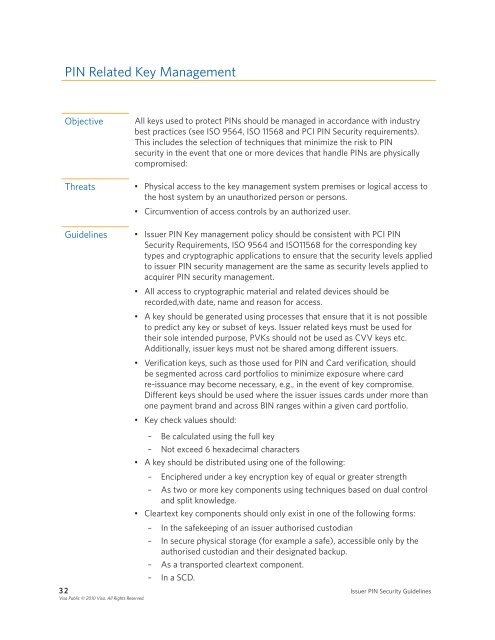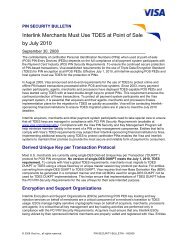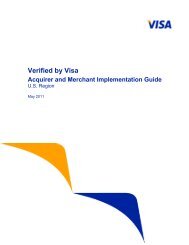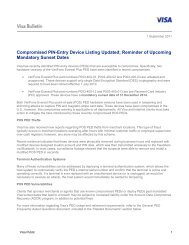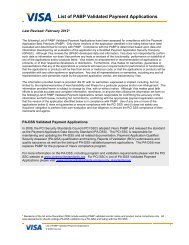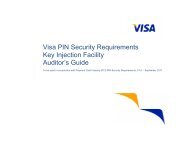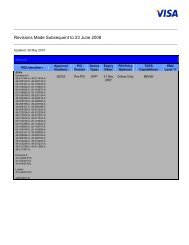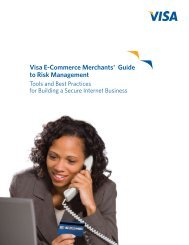Issuer PIN Security Guidelines - Visa
Issuer PIN Security Guidelines - Visa
Issuer PIN Security Guidelines - Visa
You also want an ePaper? Increase the reach of your titles
YUMPU automatically turns print PDFs into web optimized ePapers that Google loves.
<strong>PIN</strong> Related Key Management<br />
Objective All keys used to protect <strong>PIN</strong>s should be managed in accordance with industry<br />
best practices (see ISO 9564, ISO 11568 and PCI <strong>PIN</strong> <strong>Security</strong> requirements) .<br />
This includes the selection of techniques that minimize the risk to <strong>PIN</strong><br />
security in the event that one or more devices that handle <strong>PIN</strong>s are physically<br />
compromised:<br />
Threats • Physical access to the key management system premises or logical access to<br />
the host system by an unauthorized person or persons .<br />
• Circumvention of access controls by an authorized user .<br />
<strong>Guidelines</strong> • <strong>Issuer</strong> <strong>PIN</strong> Key management policy should be consistent with PCI <strong>PIN</strong><br />
<strong>Security</strong> Requirements, ISO 9564 and ISO11568 for the corresponding key<br />
types and cryptographic applications to ensure that the security levels applied<br />
to issuer <strong>PIN</strong> security management are the same as security levels applied to<br />
acquirer <strong>PIN</strong> security management .<br />
• All access to cryptographic material and related devices should be<br />
recorded,with date, name and reason for access .<br />
• A key should be generated using processes that ensure that it is not possible<br />
to predict any key or subset of keys . <strong>Issuer</strong> related keys must be used for<br />
their sole intended purpose, PVKs should not be used as CVV keys etc .<br />
Additionally, issuer keys must not be shared among different issuers .<br />
• Verification keys, such as those used for <strong>PIN</strong> and Card verification, should<br />
be segmented across card portfolios to minimize exposure where card<br />
re-issuance may become necessary, e .g ., in the event of key compromise .<br />
Different keys should be used where the issuer issues cards under more than<br />
one payment brand and across BIN ranges within a given card portfolio .<br />
• Key check values should:<br />
– Be calculated using the full key<br />
– Not exceed 6 hexadecimal characters<br />
• A key should be distributed using one of the following:<br />
– Enciphered under a key encryption key of equal or greater strength<br />
– As two or more key components using techniques based on dual control<br />
and split knowledge .<br />
• Cleartext key components should only exist in one of the following forms:<br />
– In the safekeeping of an issuer authorised custodian<br />
– In secure physical storage (for example a safe), accessible only by the<br />
authorised custodian and their designated backup .<br />
– As a transported cleartext component .<br />
– In a SCD .<br />
3 2 <strong>Issuer</strong> <strong>PIN</strong> <strong>Security</strong> <strong>Guidelines</strong><br />
<strong>Visa</strong> Public © 2010 <strong>Visa</strong>. All Rights Reserved.


